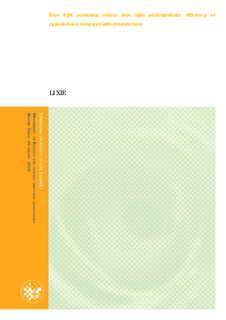| dc.description.abstract | Cyanolichens have phycobiliproteins that mainly absorb light in the green part
of the spectrum. Thereby, phycobiliproteins enhance the utilization of light transmitted through a canopy. The combination of phycobiliproteins and chl a may thus improve photosynthesis in shaded forest sites. We compared the chlorolichens Lobaria pulmonaria and Peltigera
leucophlebia with the cyanolichens Lobaria hallii and Peltigera praetextata by
measuring light response curves for photosynthetic CO2 uptake, O2 evolution,
as well as photosystem II efficiency in blue, green and red light, respectively.
Maximal photosynthetic CO2 uptake was slightly higher for both cyanolichens
than for the chlorolichens in green light. In red light there was no difference in
maximal CO2 uptake, whereas both cyanolichens had substantially lower
photosynthesis in blue light. The same trend occurred for photosynthetic O2
evolution. Apparent electron transport rate (ETR) did not differ between red
and green light in any of the species. For the cyanolichens, ETR showed no
sign of light saturation in blue light, indicating that little blue light absorbed is
used in photosynthesis. Reflectance spectra showed that green light was less reflected in the cyanolichens, which may partly explain the slightly higher cyanobacterial
photosynthetic CO2 uptake in green light. At the same time, the reflectance
patterns in the blue region cannot explain the reduced photosynthesis in
cyanolichens in blue light. Transmittance of light through the combined cortex
and photobiont layer indicated that also the blue light was efficiently absorbed.
Screening was estimated indirectly by comparing chlorophyll fluorescence
ratios between chlorophyll fluorescence excited with blue and red light. Much
lower blue/red ratios occurred in the cyanolichens L. hallii and P. praetextata
than in the chlorolichens L. pulmonaria and P. leucophlebia, indicating that
screening of blue light in the cyanolichens inhibited blue light from reaching
the photosynthetic apparatus.
Cyanobacteria may contain the UV and blue light absorbing compound scytonemin. HPLC analyses showed that L. hallii contained some scytonemin that partly may explain the blue light screening, whereas P. praetextata contained no scytonemin, Therefore, the mechanism for low cyanolichen photosynthesis in blue light remains unknown. | no_NO |
